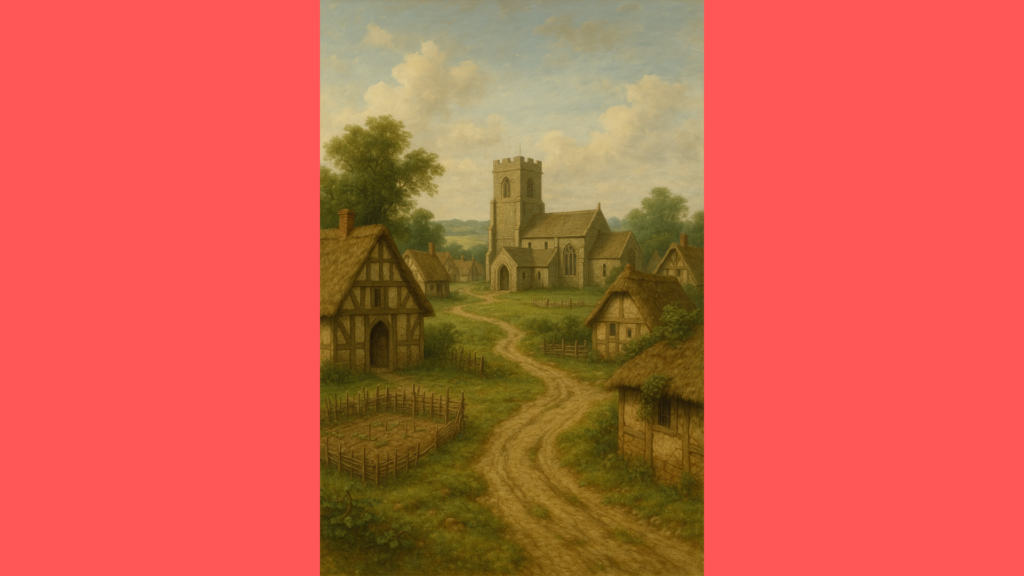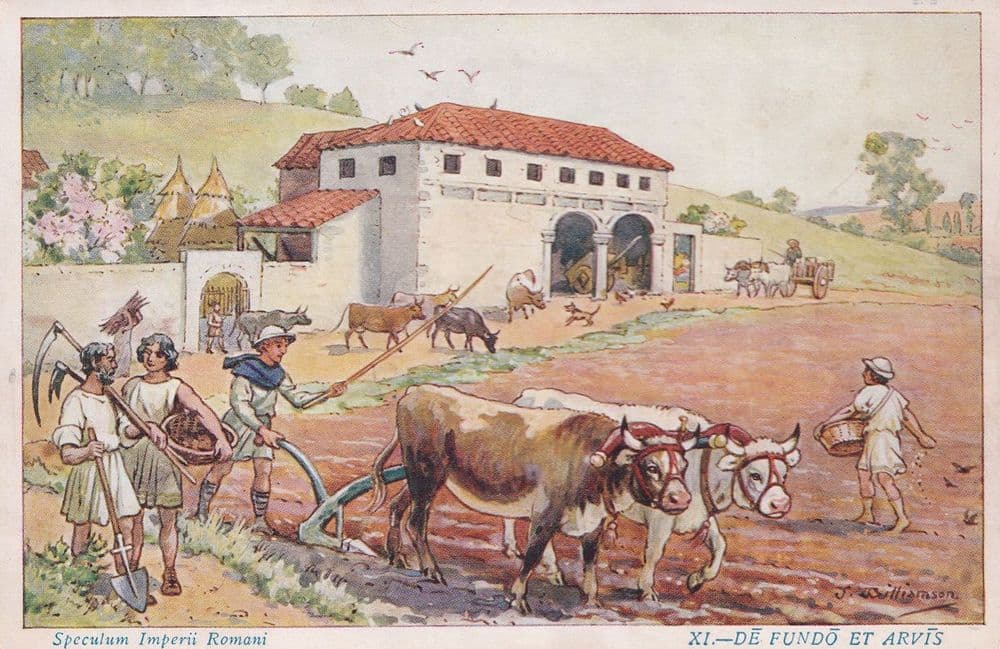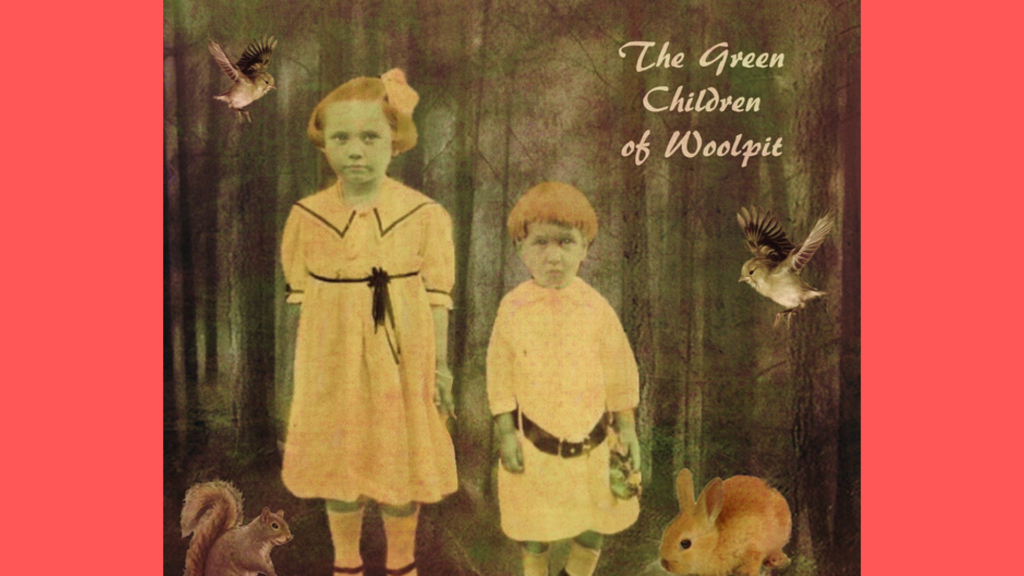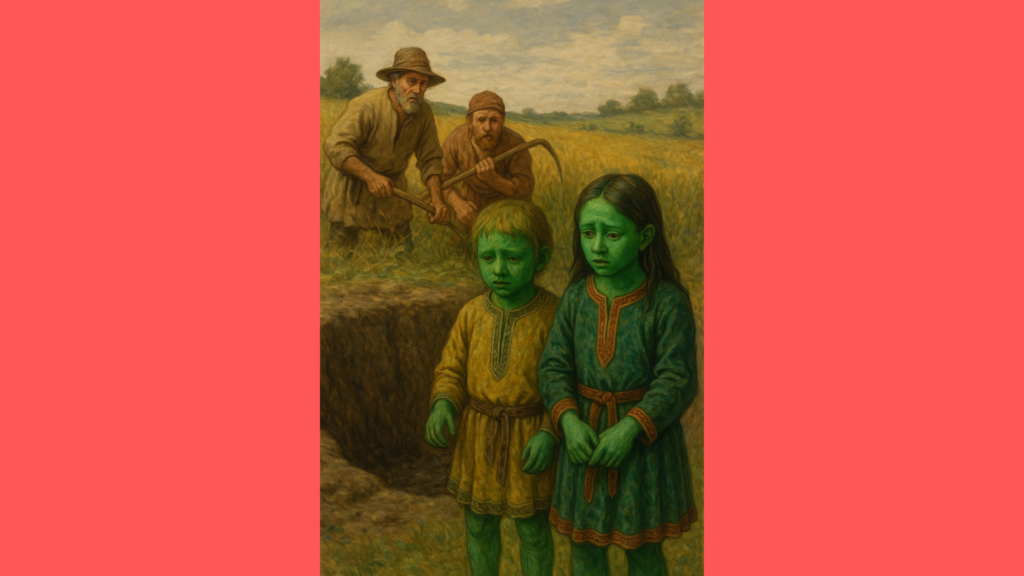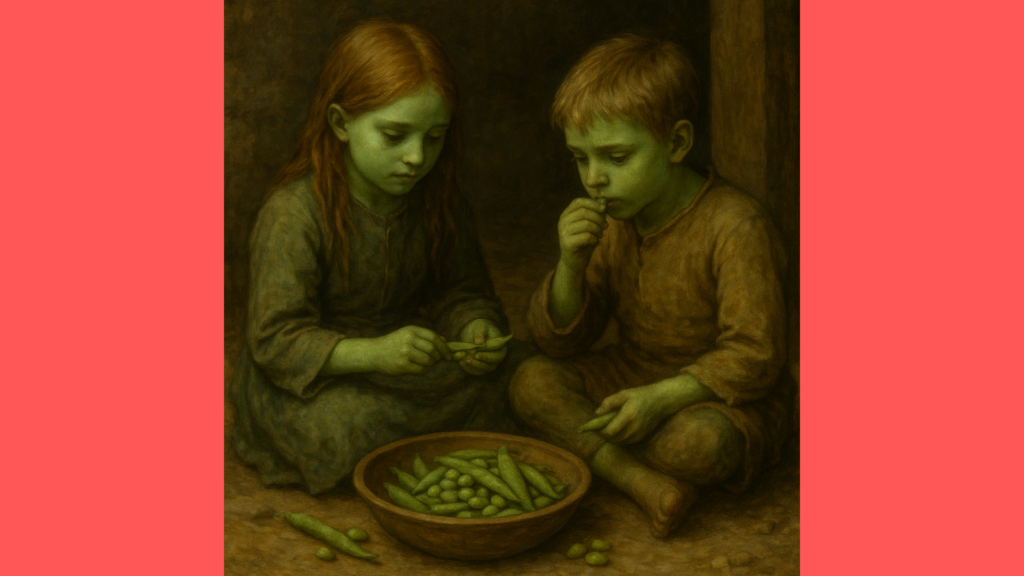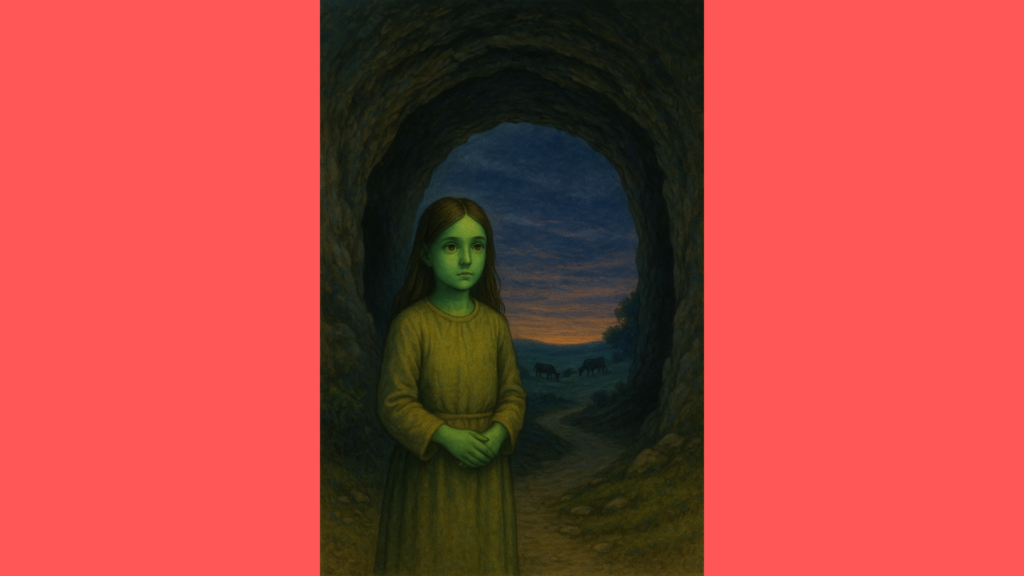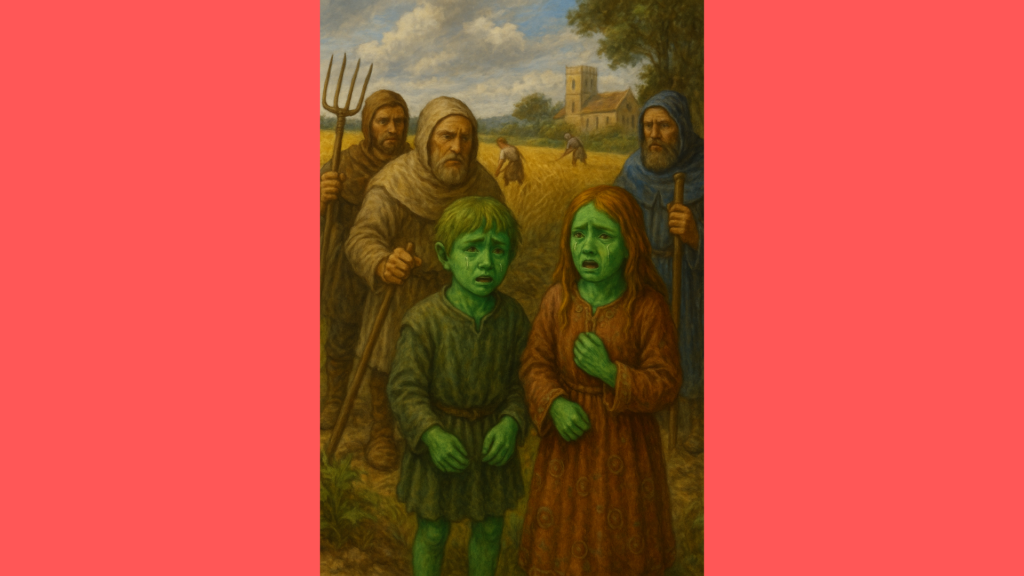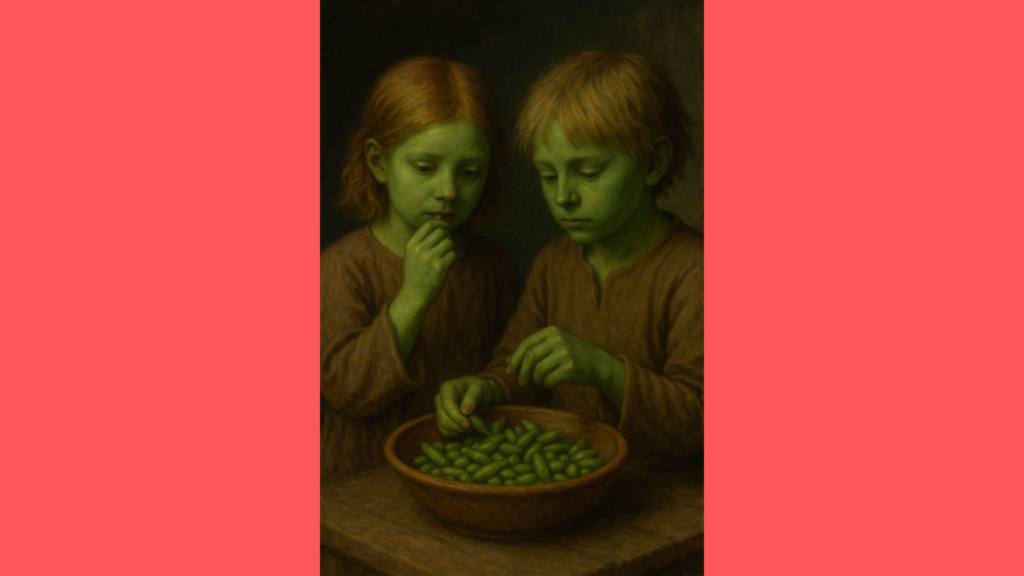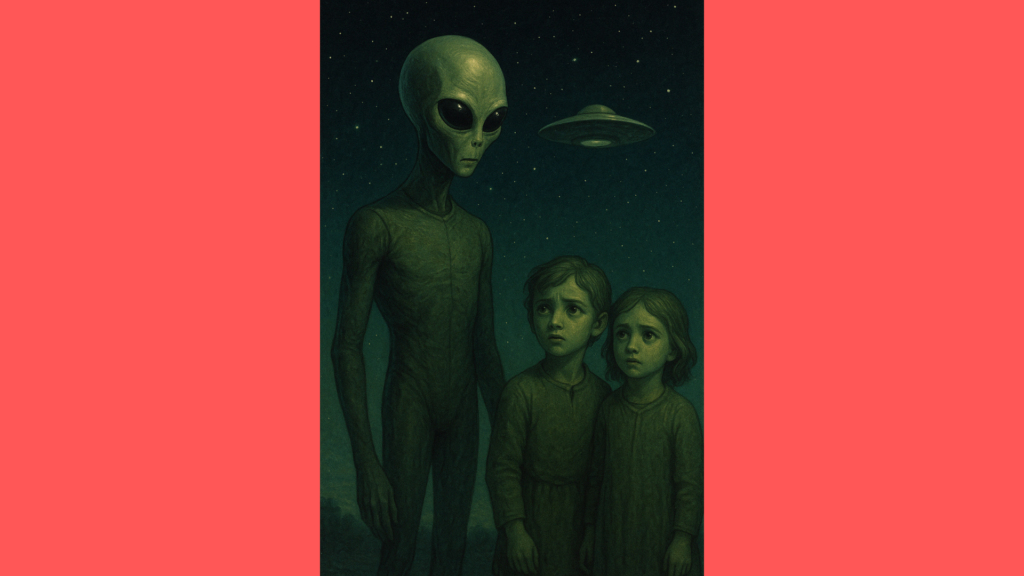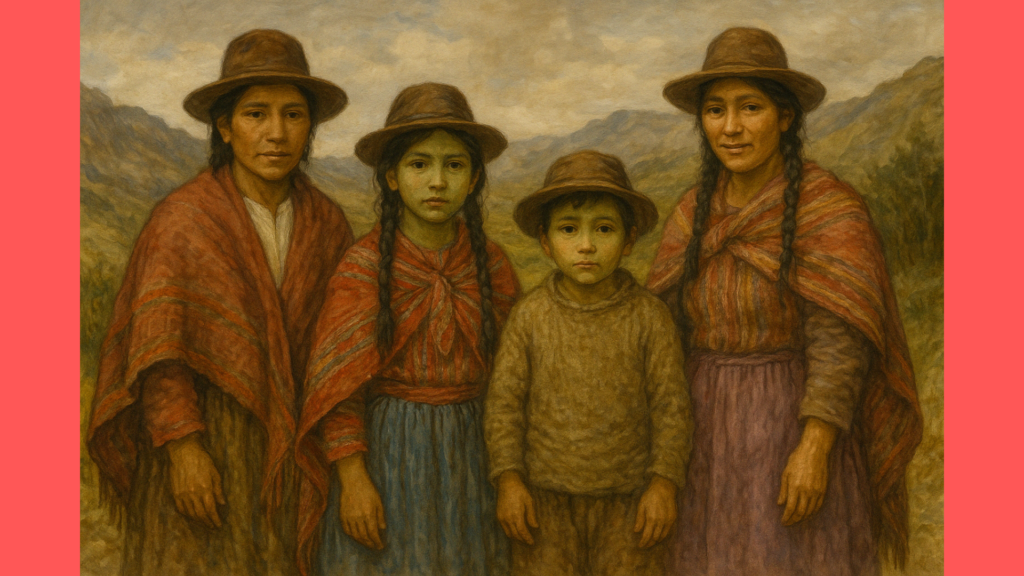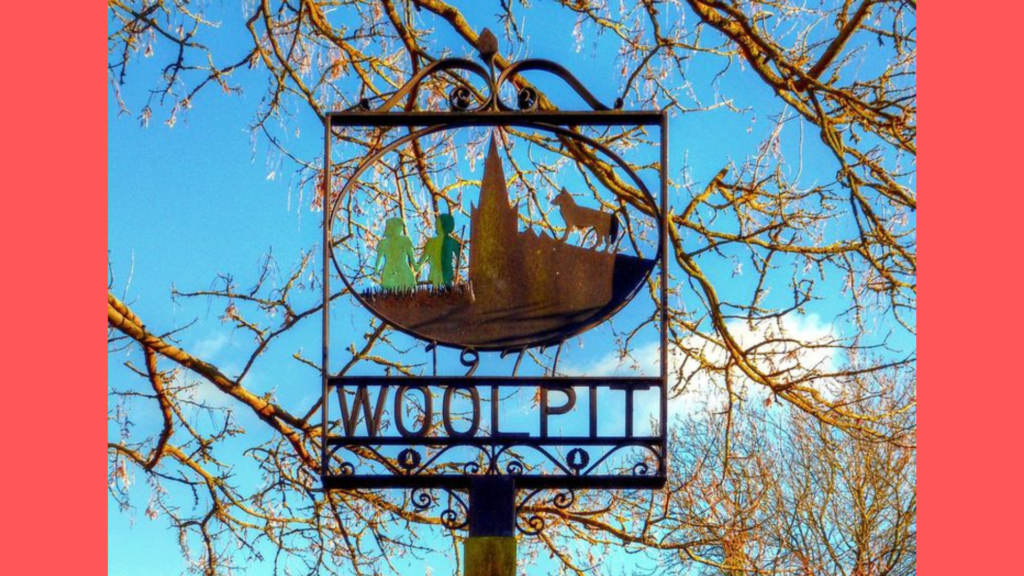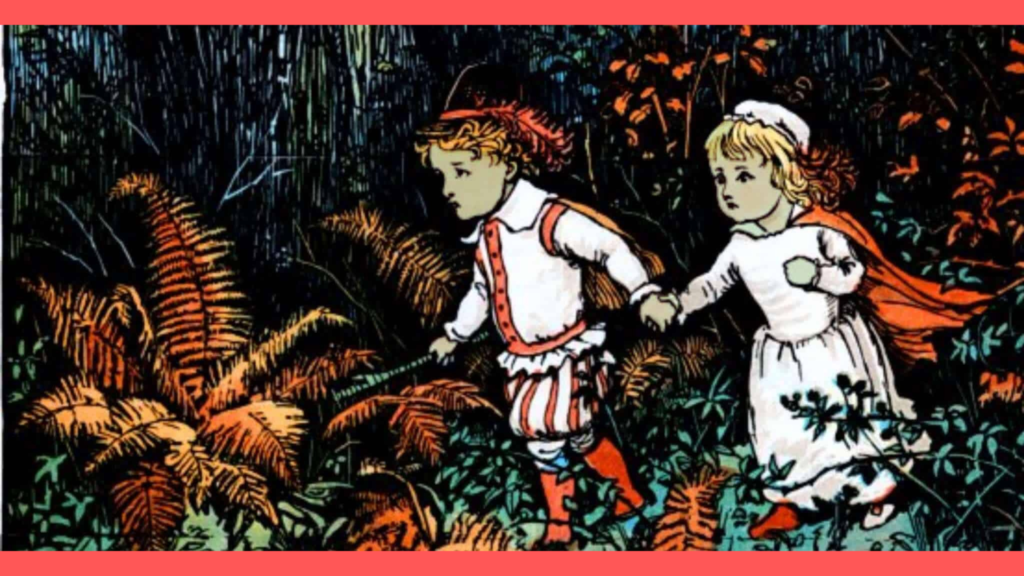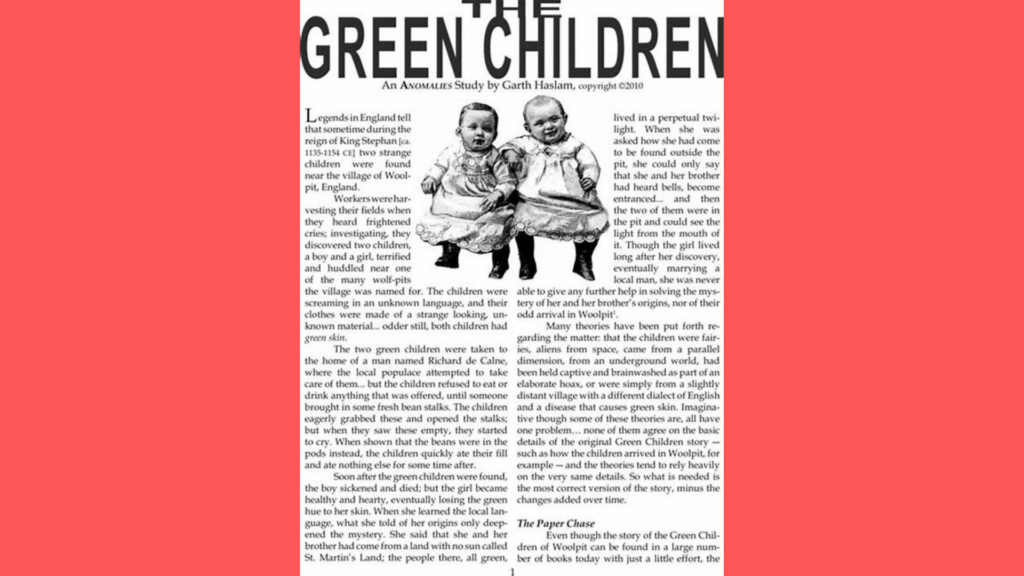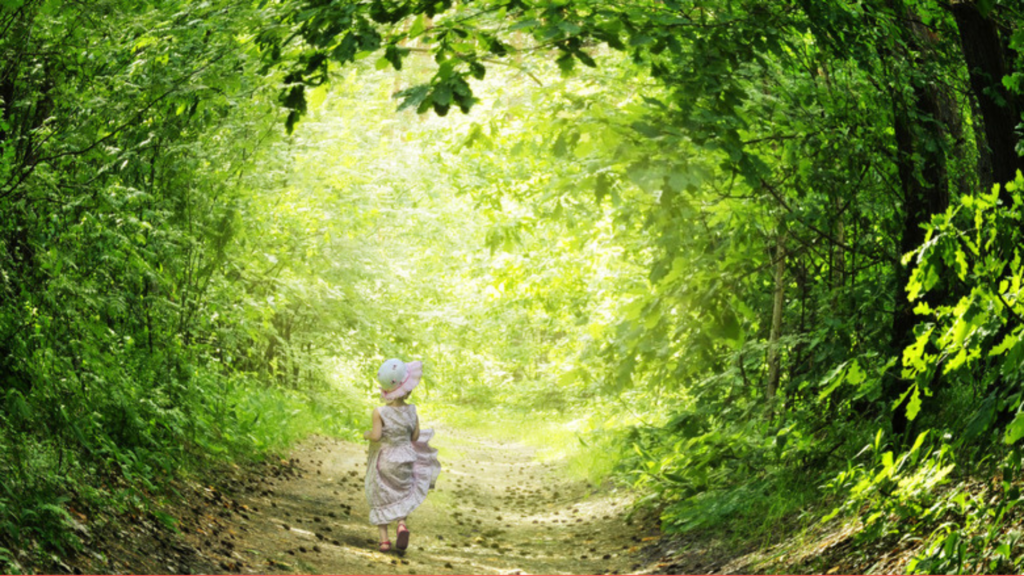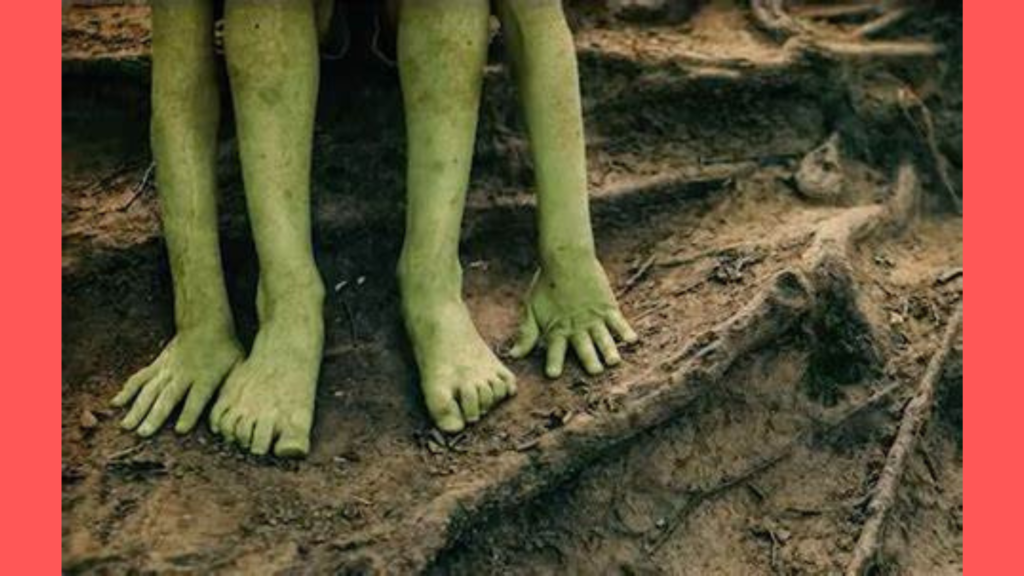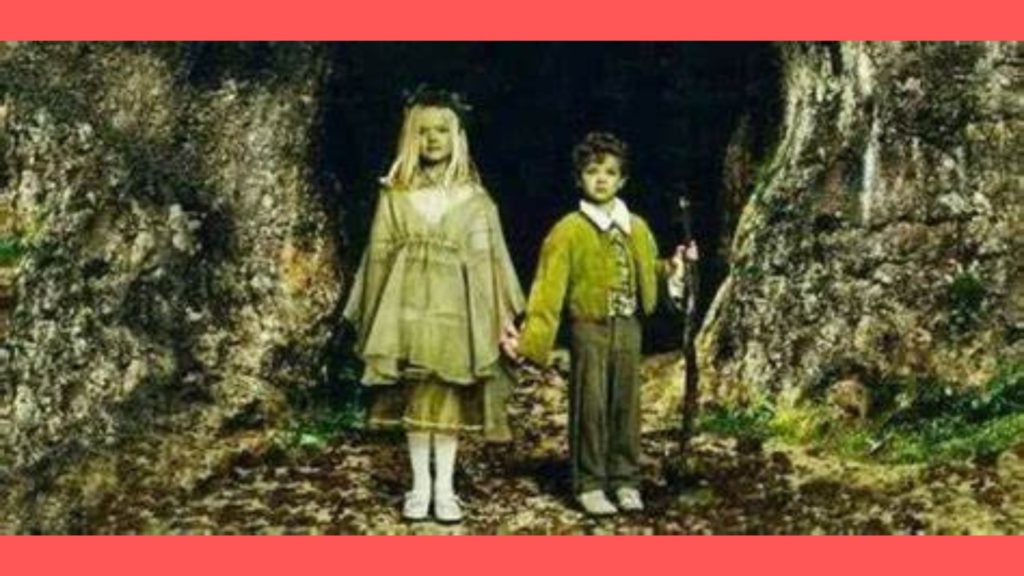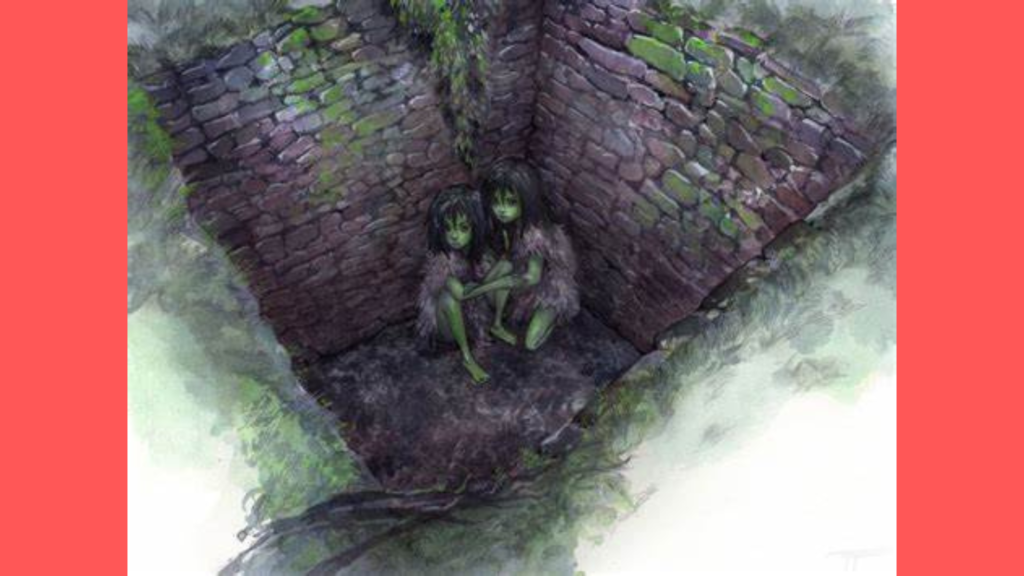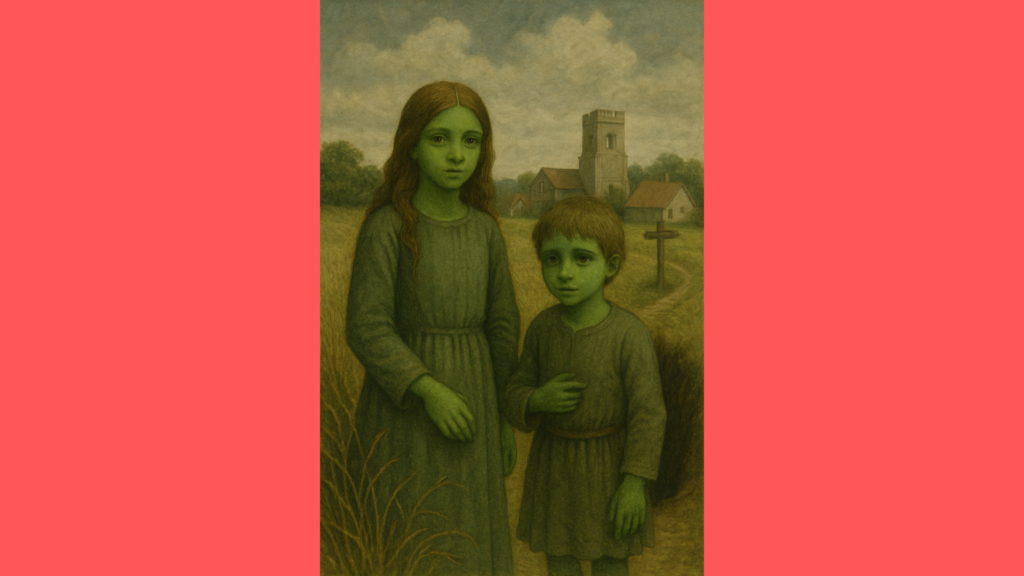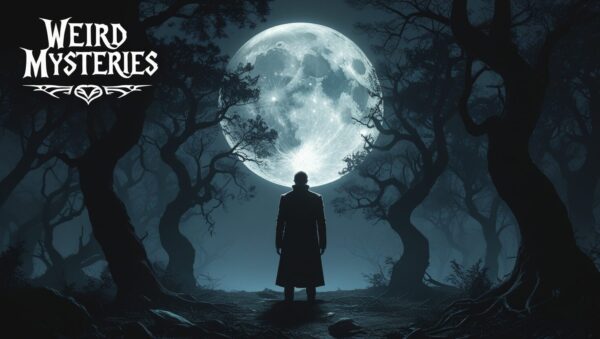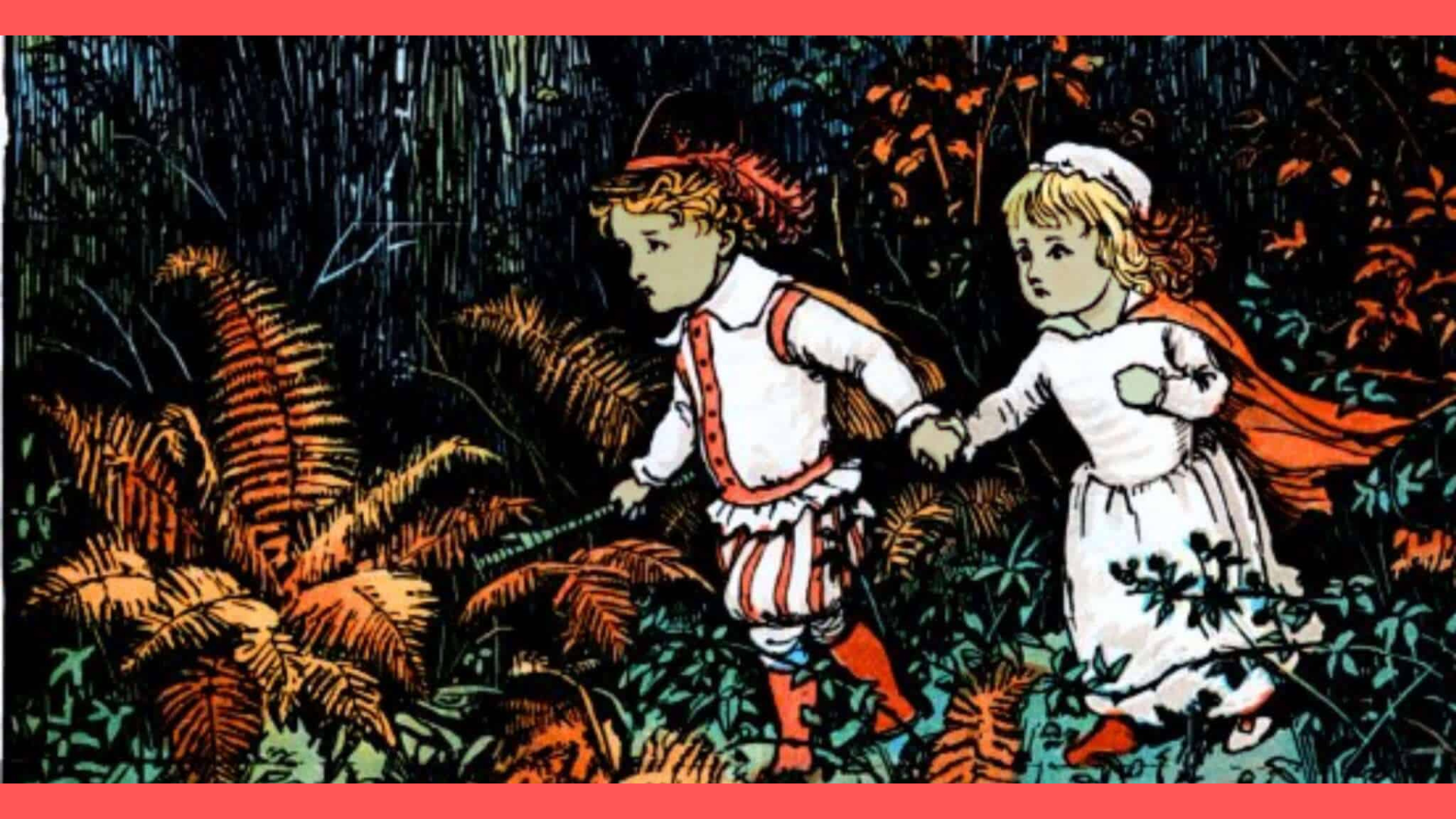
The Green Children of Woolpit (12th Century): A Medieval Mystery Beyond Time and Reason
In the heart of medieval England, where superstition walked hand in hand with faith, a small rural village became the stage for one of the most bewildering mysteries of human history. It was the 12th century, an age of knights and castles, crusades and plagues, saints and sinners. In the village of Woolpit, two strange children appeared out of nowhere—their skin tinted green, their language unknown, their origin a riddle that would echo through the centuries.
This is not just a story. It’s an unsolved enigma that blurs the line between fact and folklore, between the known world and the unseen realms that may lie just beyond it.
So, let’s travel back in time—into the dense medieval forests of Suffolk, where something inexplicable once crossed the fragile border between myth and reality.
1. Woolpit in the 12th Century – The World Behind the Mystery
To understand the impact of the Green Children, we must first understand the world they appeared in.
- The Village of Woolpit
Woolpit derived its name from Wulf-Pytt, meaning Wolf Pit, a reminder of the deep wolf traps dug in the surrounding woods to protect livestock. It was a tiny agrarian settlement, surrounded by dense forests, open fields, and the eerie silence of medieval isolation. - England in Turmoil
The time of their arrival was during or shortly after The Anarchy (1135–1153)—a bloody civil war between King Stephen and Empress Matilda. Villages were poor, superstitions thrived, and anything unexplained was attributed to divine intervention, witchcraft, or demonic forces. - Life in the Dark Ages
Imagine living in a world with no electricity, no science as we know it, and where church bells, wolf howls, and the flicker of candles in the dark were the soundtrack of your life. Into such a fearful and mystical world, two green children suddenly emerged, challenging everything people believed.
2. The Astonishing Appearance of the Green Children
One harvest day, while peasants were working the fields near the wolf pits, they saw something unearthly.
- Two small figures emerged near the deep wolf traps, trembling, holding onto each other.
- A boy and a girl, barefoot, weak, and visibly terrified.
- Their skin shimmered with a green hue—not pale, not sickly, but unmistakably green, like the leaves of early spring.
- Their clothes were unlike anything seen in England—woven from a strange material with an unfamiliar cut, neither peasant’s rags nor noble attire.
- When the villagers spoke to them, they responded with guttural, melodic sounds—a language that made no sense, not Latin, not French, not Flemish.
To the medieval mind, this was not just unusual—it was terrifying. Were they children of the Devil? Fallen angels? Faery folk? Or lost souls from purgatory?
3. The First Days: Fear, Hunger, and Strange Diets
The villagers, unsure whether to help or flee, brought the children to the manor of Sir Richard de Calne, a local nobleman known for his curiosity and kindness.
But the children refused all food. Bread, meat, cheese, and ale were pushed away with fear. Days passed, and they grew weaker and weaker.
Finally, one day, they saw freshly cut raw beans still in their stalks. They immediately grabbed them, tore the stalks open, and ate the beans raw and unboiled. For weeks, they would eat nothing but beans, slowly regaining their strength.
The villagers noted something eerie: as they adapted to normal food over time, their green hue began to fade, revealing pale human skin underneath.
4. One Survives, One Perishes
Despite the villagers’ care, tragedy struck.
- The boy grew ill and wasted away, dying shortly after baptism—an ominous reminder that not all could adapt to this world.
- The girl, stronger and more resilient, survived. She slowly learned English, began eating bread and cooked food, and her green skin eventually vanished completely.
She would go on to live a normal life, but she never forgot where she came from—and the story she told was stranger than anyone could have imagined.
5. The Girl’s Testimony: A Land of Twilight
When the girl could finally speak English, she revealed the astonishing truth about her origin.
- She and her brother came from a land of twilight, where no sun ever shone brightly. Instead, there was a perpetual dim glow, like the pale light before dawn.
- In their homeland, everything was green—the trees, the fields, the people.
- They called it St. Martin’s Land, a place filled with strange beauty and eternal dusk.
- One day, while herding their father’s cattle, they heard the sound of distant bells, soft and melodic, unlike anything they’d heard before.
- Entranced, they followed the sound into a dark cave or tunnel.
- After walking in darkness for what felt like hours, they saw a blinding light and stumbled out into the bright English countryside—completely disoriented and unable to return.
The villagers were stunned. Was there truly a hidden world beneath England? A land of eternal twilight existing side by side with our own?
6. The Fate of the Green Girl
The girl eventually adapted fully to medieval English life. Chroniclers say she became a servant in Sir Richard’s household and later married a man from King’s Lynn, Norfolk.
But people said she remained “wanton and impudent”, perhaps suggesting she kept some otherworldly boldness or free spirit that set her apart from ordinary women of her time.
7. Who Recorded This Mystery?
Two respected chroniclers wrote about the event:
- William of Newburgh (1136–1198) – A careful historian who doubted most supernatural tales, yet admitted he could not dismiss this one.
- Ralph of Coggeshall (d. 1228) – An abbot with access to local witnesses, who wrote an even more detailed account.
Their writings are considered historically credible, making the Green Children one of the most documented medieval mysteries.
8. Possible Explanations – Theories Through the Ages
The story has fascinated scholars for centuries, spawning dozens of theories.
A) A Hidden Subterranean World
Perhaps the children came from a parallel civilization beneath the earth, a place illuminated by dim light, accessible only through hidden caves.
B) Alien Visitors
Modern UFO enthusiasts see this as a possible alien encounter. The children’s green skin, strange language, and disorientation in sunlight hint at beings not entirely human.
C) Folklore & Faery Realm
Celtic legends speak of the Faery Otherworld, a place of eternal twilight where time flows differently. Could Woolpit lie near a faery portal, and the children accidentally crossed over?
D) Medical & Historical Explanation
Some historians argue they were Flemish children, refugees fleeing war. Their green skin might have been caused by chlorosis (green sickness) due to malnutrition. They spoke Flemish, which the villagers couldn’t understand.
But how did they appear out of a wolf pit with no parents? That remains unanswered.
9. Symbolism: What Does This Story Really Mean?
Beyond the mystery, the Green Children also carry deep symbolic meaning:
- Spiritual Allegory – They could represent the “lost souls of pagans”, converted by baptism but unable to survive fully in the Christian world.
- Human Curiosity About the Unknown – They embody our timeless fascination with the possibility of hidden realms and lost worlds.
- A Reflection on Fear of the “Other” – In a time of xenophobia, the children were both feared and pitied.
10. Legacy: How the Mystery Endures
The story of the Green Children has inspired:
- Herbert Read’s novel The Green Child (1935)
- Countless folklore studies, TV documentaries, and podcasts
- Modern sci-fi about parallel universes and dimensional portals
- Tourism in Woolpit, where people still search for traces of the mystery
Even today, Woolpit has signs and landmarks honoring the tale. Some say that on quiet nights, you can still hear faint bells in the woods…
11. Could It Happen Again?
What if hidden realms really do exist? What if there are thin places where worlds overlap, and sometimes, someone crosses by accident?
The Woolpit case raises haunting questions:
- Are there other lost lands beneath our feet?
- Can children accidentally stumble into places adults can’t see?
- Was this an isolated event—or just one of many such crossings that remain unrecorded?
12. Why the Green Children Fascinate Us Even Now
This story remains eternal because it touches something deep within the human imagination:
- Our longing for undiscovered worlds
- Our fear of the unknown
- Our hope that reality might be more magical than it seems
It’s a story that cannot be fully explained, and that’s why it will never die.
Conclusion: The Unsolved Riddle of Woolpit
The Green Children of Woolpit are more than just a medieval curiosity. They are a reminder that not everything has an answer. Whether they were malnourished orphans, visitors from a hidden realm, or wanderers between worlds, their story remains one of the most haunting unsolved mysteries of history.
Perhaps the truth was lost centuries ago… or perhaps it waits in the twilight of St. Martin’s Land, beyond the reach of our understanding.
So, next time you walk in a quiet forest, listen carefully. You might hear distant bells, faint but persistent, calling you toward a place you were never meant to see…
50 Rarely Found FAQs About The Green Children of Woolpit
1. When exactly did the Green Children of Woolpit appear?
Historians are unsure of the exact year, but most agree it happened between 1135 and 1189, during the reign of either King Stephen or Henry II, in the aftermath of The Anarchy, a civil war in England.
2. Why is Woolpit considered significant in medieval folklore?
Woolpit was a wolf-trapping village, surrounded by dense forests. Its wolf pits symbolized danger and mystery, making it an ideal setting for supernatural legends.
3. Did any villagers witness how the children first arrived?
No one actually saw them emerge from the wolf pits. They were discovered wandering and crying, suggesting they appeared suddenly without a visible entry point.
4. Why were the children’s clothes considered strange?
Their clothes were made from unknown fabric and cut in an unfamiliar style—not like English peasant attire nor noble garments, hinting at a foreign or otherworldly origin.
5. Could the Green Children’s language have been an early lost dialect?
Some linguists speculate it might have been a forgotten Flemish dialect, while others think it could have been a completely isolated tongue from a hidden community.
6. Did the children ever mention their parents?
The girl never described her parents in detail. She only said they lived in St. Martin’s Land, suggesting family structures there were similar but mysterious.
7. What does “St. Martin’s Land” symbolize?
In medieval Christianity, St. Martin was a protector of the poor and travelers. The name could hint at a realm of safety for lost souls, or it might have been a literal place in their world.
8. How did the villagers react spiritually to the children?
Many thought they were souls from purgatory, sent as a test of faith. Others feared they were faeries or demonic changelings, leading to debate within the village.
9. Why did the children reject normal medieval food?
They were accustomed to raw plant-based diets. Their initial refusal may reflect a different cultural or biological adaptation in their homeland.
10. Why did the boy die but the girl survive?
Historians believe the boy’s body could not adapt to Woolpit’s food and sunlight, while the girl’s resilience allowed her to adjust gradually.
11. Did the girl retain any green skin as an adult?
No. Chroniclers say her skin completely lost the green hue, suggesting it was a temporary condition caused by diet or environment.
12. What happened to the girl after marriage?
She reportedly married a man from King’s Lynn, Norfolk, but her later life is unrecorded, fueling speculation that she returned to her homeland secretly.
13. Could the children’s twilight land have been underground?
Yes. Some theories suggest a subterranean civilization illuminated by dim light, explaining the children’s sensitivity to bright sunlight.
14. Were there other reports of green children in medieval Europe?
There are few scattered legends in Germany and Spain about green-skinned beings, but none as detailed and documented as Woolpit’s case.
15. Did the villagers search for the cave the children mentioned?
No medieval record mentions a search. Either the villagers dismissed it as childish fantasy, or they feared finding forbidden places.
16. Could the children have been time travelers?
Some modern theorists suggest they may have slipped through time, coming from either the distant past or a future where the sun was dimmer.
17. Was the green skin symbolic of disease?
It may have been chlorosis (green sickness), caused by severe iron deficiency, which was unknown to medieval medicine at the time.
18. Why did only chroniclers record the story?
Oral stories likely circulated, but only educated monks and abbots like Ralph of Coggeshall wrote them down, preserving them for posterity.
19. How reliable are William of Newburgh and Ralph of Coggeshall?
Both were respected historians known for skepticism toward superstition, making it unusual that they recorded this tale seriously.
20. Could the children have been survivors of a hidden Flemish community?
Yes. Flemish settlers in England faced persecution, and lost refugee children could have wandered into Woolpit after fleeing.
21. Why is Woolpit still linked to supernatural tourism?
Even today, Woolpit has landmarks, plaques, and local legends that attract visitors curious about the mystery.
22. Did medieval people associate the children with faeries?
Yes. The green skin and twilight homeland closely resembled Celtic faery lore, where beings lived in hidden lands parallel to ours.
23. What were the bells the children heard before arriving in Woolpit?
They described soft bell-like sounds, possibly from a medieval church. Some think these sounds were dimensional echoes guiding them out.
24. Could St. Martin’s Land represent purgatory?
Yes. In medieval theology, twilight realms were symbolic of souls between heaven and earth, possibly explaining the children’s origin.
25. Was the girl afraid of telling her story?
Chroniclers say she was hesitant and often quiet about her past, perhaps fearing disbelief or punishment.
26. Did the villagers baptize the children out of fear?
Yes. Baptism was seen as protection against demonic influence, so the villagers baptized them quickly.
27. How long did the girl live in Woolpit?
She lived for several years, working for Sir Richard de Calne, but her exact age at death is unknown.
28. Could there be hidden tunnels near Woolpit even today?
Some locals believe ancient tunnels still exist, but no confirmed archeological evidence has been found.
29. Did the girl ever try to return to St. Martin’s Land?
There is no record of any attempt, which might mean she couldn’t find the portal again—or chose to stay.
30. Did the villagers ever fear more green children would appear?
Yes. Woolpit locals reportedly kept watch over the wolf pits for years, but no others were ever seen.
31. Could the green children have been related to Hollow Earth legends?
Yes. The idea of a hidden inner world beneath the surface matches both their story and later Hollow Earth theories.
32. Did other medieval texts mention Woolpit’s mystery?
Apart from the two main chroniclers, no major medieval text expands on the event, making it uniquely mysterious.
33. Could they have been abandoned noble children?
Unlikely, as their clothing and language didn’t match any known aristocratic customs of England or Europe at the time.
34. Did they have any unusual physical features besides green skin?
Chroniclers noted they looked normal in shape and size, only their skin color and language were strange.
35. Could St. Martin’s Land have been another dimension?
Yes. Some theorists believe they crossed a dimensional rift, accidentally stepping into Woolpit’s reality.
36. Was there any connection to UFO sightings in medieval England?
No direct link exists, but “fiery wheels” in the sky were recorded in medieval chronicles, sometimes tied to otherworldly visitations.
37. Did the girl describe the animals in her homeland?
She said cattle were similar but didn’t mention other creatures, leaving scholars puzzled about their biodiversity.
38. Why were they drawn to the sound of bells?
Church bells symbolized safety and spirituality, suggesting the bells either guided them or pulled them across realms.
39. Could they have been mythical changelings?
Yes. Changelings in folklore were children swapped by faeries, often sickly or different from normal human children.
40. Did the villagers ever record any strange weather or lights that day?
No unusual weather was mentioned, but medieval chroniclers often omitted environmental details.
41. Could they have been survivors of a secret underground tribe?
Possibly. Ancient Britain had forgotten cave-dwelling communities, which could explain their pale-green adaptation.
42. Did the girl remember the cave entrance?
She said it was dark and endless, but never described an exact location or how to find it again.
43. Was the twilight of St. Martin’s Land caused by a dim sun?
Yes. She described it as a world where the sun never fully shone, like a place in perpetual dusk or polar twilight.
44. Could they have been escaped slaves from another land?
No evidence suggests slavery; their story didn’t match known migration routes or conflicts of the time.
45. Did their appearance influence medieval art?
Yes. Some church carvings and tapestries later depicted green-skinned children or faery folk, likely inspired by Woolpit.
46. Were the children’s eyes described?
Sadly, chroniclers did not describe their eyes in detail, leaving speculation about unusual eye color or shape.
47. Could Woolpit have been a “thin place” in folklore?
Yes. Celtic folklore speaks of thin places where the veil between worlds is weaker—Woolpit could have been one.
48. Was their diet in St. Martin’s Land plant-based only?
She only mentioned beans and green plants, suggesting they may have been vegetarian or had no access to livestock meat.
49. Why didn’t the girl’s descendants continue the story?
Her children, if any, might have hidden the truth out of fear, or her line ended without heirs, erasing the oral tradition.
50. What lesson did medieval people draw from the Green Children?
They saw it as a warning about divine mysteries—a reminder that God’s world was bigger than anyone understood.


